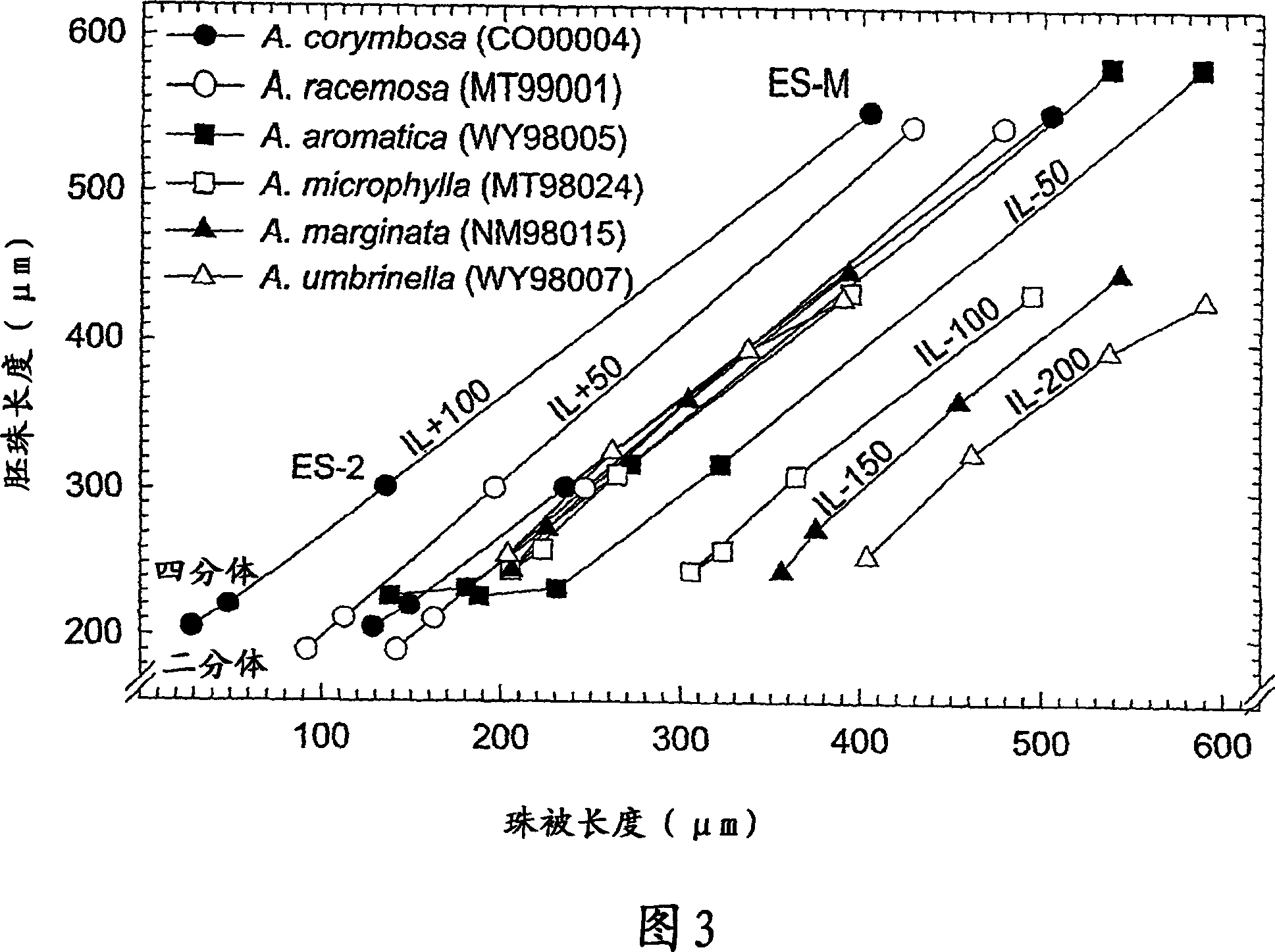Methods for increasing the frequency of apomixis expression in angiosperms
A technology of apomictic reproduction and increasing frequency, applied in the field of increasing the expression frequency of apomictic reproduction in angiosperms, and can solve the problems of low apomictic penetrance, instability, etc.
- Summary
- Abstract
- Description
- Claims
- Application Information
AI Technical Summary
Problems solved by technology
Method used
Image
Examples
Embodiment 1
[0185] SELECTION OF STRAINS OF PILLARIZA PLANTS PRODUCING APOCOMITIC ENHANCED PLANTS
[0186] Apomixis was first described at the embryological level in Antennaria alpina (Juel 1900). Papilionaceae (x=14) are dioecious herbaceous perennials, usually with stolons. Morphology-based clade analysis of 32 sexually diploid species combined with analysis of sequenced internally transcribed spacers (ITS-1 & ITS-2) of nuclear endosomal DNA indicated that the genus Pteropus consists of 6 Clade composition (Bayer 1990; Bayer et al. 1996). Apomixis occurs only in the Catepes clade, which contains 17 of the 32 sexual Pteropus species and 4x to 12x sexual and apomictic polyploidy (Bayer and Stebbins 1987; Bayer and Minish 1993) . All members of this group have stolons and are sexually dimorphic. Five geographically divergent complexes (agamic complexes) obtained by hybridization between sexual and apomictic species of the genus Pteropus, A.alpine(L.)Gaetn., A.howellii E.L.Greene , A....
Embodiment 2
[0193] Selection of Sorghum lines from which plants with enhanced apomixis can be produced
[0194] There is evidence of low levels of facultative apomictic seed formation (no more than 25%) in at least some Sorghum lines (Hanna et al. 1970; Tang et al. 1980; Schertz 1992; Bala Ravi 1993). To assess whether apomixis in these lines arose from crossing rather than accidental mutation, we tested the null hypothesis that apomixis could not have arisen by crossing ancestral lines of known facultative apomictic Sorghum of hybrids produced. To our knowledge, this simple test has never been performed before, ie, conventional wisdom holds that apomixis arises by mutation. Progenitors of two facultative apomixis Sorghum lines 'R473' and '302' were obtained. The ancestors of R437 were 'IS 2942' (day-neutral Kafir line) and 'Aispuri' (short-day Indian variety) (Tang et al. 1980). The ancestors of 302 were 'IS 3922' and 'Karad Local' (Rana et al. 1981). A total of 20 species of Sorgh...
Embodiment 3
[0199] Characterization of GDS variation in Sorghum lines and generation of plants expressing apomixis
[0200] Pistils for cytological analysis were sacrificed, fixed, cleared and visualized by DIC microscopy as described in Peel et al. (1997a,b). Obtain MMC, dyad, triad / tetrad, functional megaspore, 1-nucleated embryo sac, 2-nucleated embryo sac, 4-nucleated embryo sac, early 8-nucleated embryo sac, mature embryo sac, exposed stigma and mature seeds Phase cytology data. For each ovule analyzed, the following data were obtained: meiotic or embryo sac development stage, pistil length and width, integument length and width, and sex mother cell or embryo sac length and width. Tables 3-4 illustrate a summary of data from MMC to mature embryo sac stages used for GDS characterization of Sorghum lines (data from line SB1001.1 shown). Additional data tables are used to obtain cytological data at the stigma-exposed and mature seed stages. Plants of Table 2 were cultivated, embryo...
PUM
 Login to View More
Login to View More Abstract
Description
Claims
Application Information
 Login to View More
Login to View More - R&D
- Intellectual Property
- Life Sciences
- Materials
- Tech Scout
- Unparalleled Data Quality
- Higher Quality Content
- 60% Fewer Hallucinations
Browse by: Latest US Patents, China's latest patents, Technical Efficacy Thesaurus, Application Domain, Technology Topic, Popular Technical Reports.
© 2025 PatSnap. All rights reserved.Legal|Privacy policy|Modern Slavery Act Transparency Statement|Sitemap|About US| Contact US: help@patsnap.com



